What is Amazon Handmade?
I’m a creative person but I never got a chance to explore my creative interests when I used to work in a corporate job as a management consultant.
I had dreams about starting a business and creating my own products but it always felt slightly out of reach.
I couldn’t see how I could balance starting a business with working full time, plus I didn’t have lots of savings to get me started. After lots of research and a few false starts, I came across selling on Amazon.
I dived in headfirst and learned everything I possibly could about selling on Amazon. There were no straightforward guides to follow at that point so I spent a lot of time trawling through information on the internet, signing up to various courses and meeting with manufacturers.
As soon as I got my first sale on Amazon I was hooked!
I’ve been able to grow my handmade business incredibly quickly, something that just wouldn’t be possible if I was starting a brand off Amazon.
Since starting my Amazon business I have been able to quit my corporate job and travel while working on my ecommerce business. There’s no chance I would have been able to do this if I had stayed in my old corporate job.
Over the course of growing my business, I have provided coaching to other sellers, a number of whom are handmade sellers. I have watched closely as Amazon has grown it’s Handmade category and I have seen an increasing number of new handmade sellers who are getting fantastic results through the online marketplace.
I believe it’s one of the most exciting areas on the Amazon marketplace and it’s only going to go from strength to strength.
A step by step guide to Amazon Handmade
Before we start, let me tell you upfront that Amazon can be seriously overwhelming.
I remember that feeling well when I first started selling on Amazon a few years ago. At that time there was no simple guide, no easy to follow steps and everything needed to be figured out from scratch.
Fortunately, if you’re looking for a clear step-by-step guide to selling on AmazonHandmade, then you’re in the right place. I know there feels like there’s a lot to learn and all this jargon to get your head around, but this easy-to-follow guide will get you on the right path.
I work with a lot of handmade sellers who are looking to increase their sales online. I initially made this easy-to-follow guide for them but later I realised that there are a lot of people out there who are interested in selling their beautiful handmade products on Amazon and could benefit from a roadmap like this.
This guide tells you exactly what you need to know about Amazon Handmade so you can work out whether it’s right for you and then quickly work through the Amazon Handmade registration process.
As you’ll see I think it’s an awesome opportunity which all handmade sellers should consider!
PS. There are a few checklists and guides that will help you work through this guide.
You can find them all here.
Part 1: Why Amazon Handmade
Is Amazon Handmade worth it?
Amazon Handmade is an artisan-only community started in 2015. It’s like a separate store within the Amazon marketplace which appears as a category option in the search bar.
Amazon recognises that handmade businesses are different from other types of businesses so it has slightly different rules and pricing to the rest of the marketplace.
To sell on Amazon Handmade you need to submit an application proving that you are a handmade seller. This keeps the Amazon Handmade marketplace selective and ensures that you don’t get sellers pretending to sell handmade items but actually selling mass-produced products which you can get on other online marketplaces.
Although it requires a bit more work, it’s actually great news for makers and we’ll discuss the application process in-depth in the coming pages.
The application process means it’s much less competitive than selling on the rest of Amazon so you get access to Amazon’s huge online marketplace but without the usual competition.
Your products will appear under the Amazon Handmade category but also in general Amazon searches.
Amazon Handmade includes other perks such as no monthly selling fees, the option to create an Artisan profile to market your products and access to Amazon’s world-leading fulfilment network.
The message here is that Amazon really wants to support handmade sellers on its platform.
How much can you make selling on Amazon Handmade
As of 2019, there were approximately 25,000 Amazon sellers making over $1 million worth of sales and 200,000 Amazon sellers making over $100,000 worth of sales. Just take a look at these top performers in Amazon Handmade:
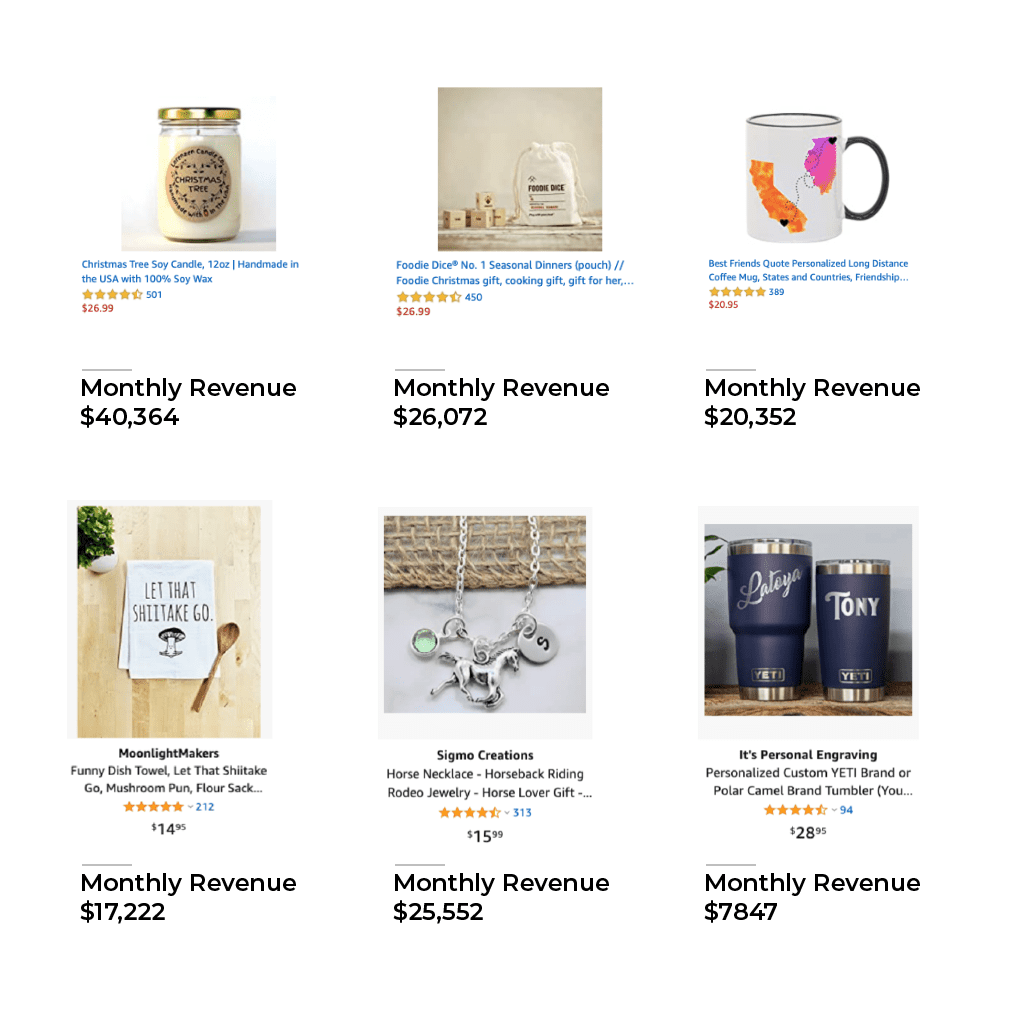
These are superstar products no doubt. But many of our clients have achieved outstanding results through Amazon Handmade.
One of these clients is Carol. Carol is a fantastic upholsterer and the owner of Yorkshire Quilts, a business she has built up over the past 5 years creating bespoke cushions and covers for local customers.
Carol was keen to increase her orders and after some googling, she came across Amazon Handmade.
I helped Carol get set up and sell on Amazon Handmade in the UK and within 4 months, Carol had tripled her monthly orders, going from 100 orders just in her shop to 200 just on Amazon.
Amazon Handmade vs Etsy
The number of shoppers on Amazon blows every other marketplace out of the water, plus as a seller on Amazon, you also have access to multiple international marketplaces.
Just to put it in perspective, Amazon has 2.5 billion monthly visits, and 90% of all U.S. consumers have shopped on the platform. Take a look at the statistics below:
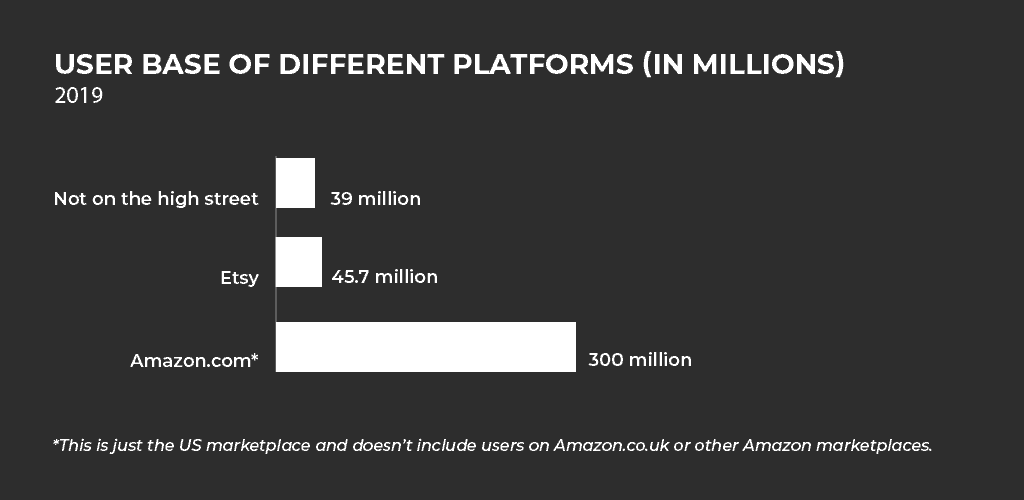
The opportunity on Amazon Handmade is huge and that’s because there is so much traffic which is increasing all the time. As a UK seller, you might choose to focus entirely on Amazon.co.uk or you could also sell on Amazon.com or one of the European marketplaces.
Amazon’s fulfilment network, which I’ll come onto later, makes it easy to sell to Amazon’s huge customer base regardless of where you are based in the world. By selling in the UK, you also have access to the entire European market for no extra cost, apart from increased postage.
Likewise, when you sign up for North America, you also get access to Canada and Mexico.
This is an incredible opportunity for sellers who really want to grow their business.
How competitive is Amazon Handmade?
If you’re not familiar with Amazon Handmade, you might be surprised to know that Amazon Handmade is actually not as competitive as Etsy.
Because Amazon Handmade has an application process to ensure that all the goods on the platform are made by artisans, it is far more exclusive and selective, which is great news for legitimate handmade sellers.
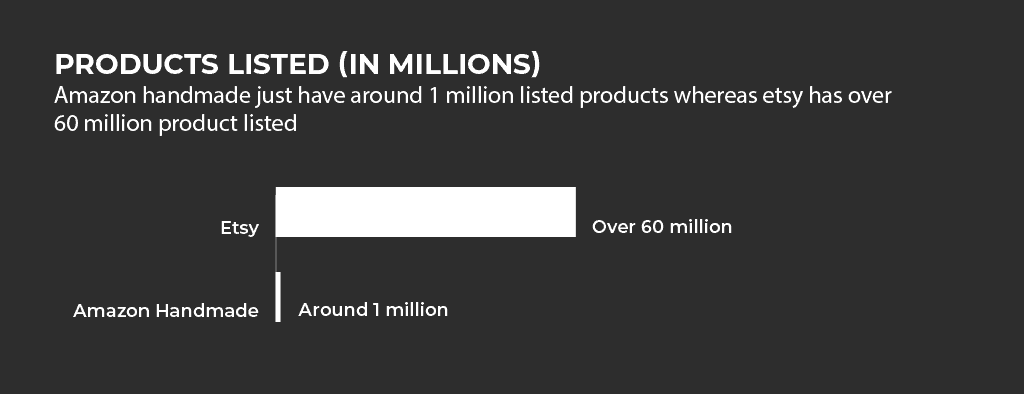
It’s also still a relatively new category. At some point, it may very well be as competitive as some of the more mature categories on Amazon but right now it’s still in its infancy and this offers sellers a fantastic opportunity to get in early.
Contrast that with Etsy which is a much more mature marketplace in terms of the number of sellers.
Etsy is far less restrictive about who is allowed to sell on its platform and as a result, there are increasing numbers of Chinese companies on there selling mass-produced items at very cheap prices.
It can be hard for small handmade artisans to compete and get their products seen on Etsy.
Let’s look at Carol’s company, Yorkshire Quilts.
Cushions is a highly competitive area on Etsy. When you type “cushion” into the Etsy search bar you get 647,774 results! But when you type cushions into the Handmade category on Amazon.co.uk you get 8000 results. That’s 80 times as much competition on Etsy!
One of the reasons Carol chose to try Amazon Handmade was because she didn’t want the uphill struggle of trying to compete on Etsy. By selling on Amazon Handmade it’s far easier for her to stand out and get her products seen so she can make sales.
Amazon Handmade Pros and Cons
There are a lot of advantages to selling on Amazon Handmade. As I’ve already covered, its customer base is unrivalled and the low competition creates a fantastic opportunity to get your products seen by customers.
Amazon’s fulfillment capabilities and the branding options which it offers handmade sellers (which I’ll cover later on) are also great selling points. It also means I have been able to set up a European store and an American store, even though I am based in the UK.
But as with any marketplace, there are potential drawbacks – the most noticeable of which are the fees, payment structure and customer data.
Again, I will cover these in more detail later on but it’s worth looking at how Amazon Handmade matches up against Etsy and Not on the High Street on some key points:
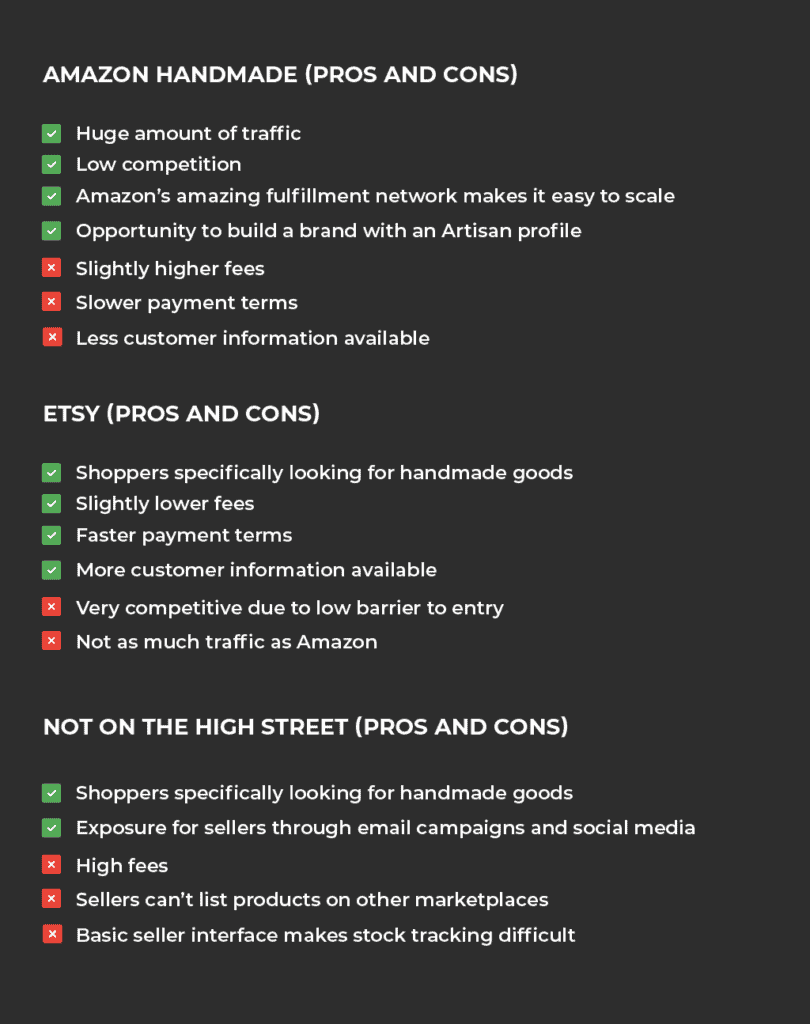
Now I’ve covered the opportunity and the pros and cons, you should have a clearer idea about whether Amazon Handmade is right for you and your products. In the next chapter let’s look more closely at how the marketplace works.
PART 2: How does Amazon Handmade work?
What are Amazon Handmade seller fees
What are the Amazon Handmade seller fees?
Amazon’s fee structure is a little different to other marketplaces such as Etsy and it’s important to understand exactly how it works.
Is there a monthly fee to sell on Amazon Handmade?
One of the perks of selling in the Amazon Handmade category is that Amazon waives the monthly seller fee so you have one less thing to worry about as a new seller!
In order to sell on Amazon, you will need to sign up to a Professional Selling Plan which comes with a monthly fee of £25 for Amazon.co.uk ($39.99 for Amazon.com).
There is a free plan called the Individual Selling Plan but this is just for selling one-off items so I would always recommend that you sign up for the Professional Selling Plan.
What is the Amazon Handmade Referral and listing fee
Amazon doesn’t charge product listing fees, in other words, it doesn’t charge you a fee when you list a product on the marketplace.
Instead, it charges a referral fee per sale. This is like Amazon’s commission, which it takes from each sale you make, in return for running the marketplace and bringing potential customers to your products.
That means you don’t pay a penny until you make a sale. That’s great news for a new handmade seller.
The current referral fee for Amazon Handmade products is 15%.
When you start comparing different marketplaces you’ll notice that they all refer to their fees in different ways and this can make it difficult to compare them.
Amazon has a reputation for charging higher fees than Etsy and while it certainly takes a larger fee from each product sale (what it calls a referral fee), this is the only fee you pay.
Etsy on the other hand charges a number of smaller fees which all add up. It’s worth looking at how all these fees compare:

Let’s look at an example:
One of Carol’s best sellers on Amazon Handmade is a cushion that sells for £29.99.
When she sells a cushion on Amazon Handmade her fees look like this:
Transaction fee: – £4.5
Proceeds: £25.49
If Carol sold the same cushion on Etsy, her fees would look like this:
Listing fee: – £0.20
Transaction fee: – £1.95
Payment Processing fee: – £0.25 + £0.90
Proceeds: £26.69
As you can see there is just over a pound difference when all the fees are taken into account.
Clearly, Etsy’s fees work out slightly cheaper for sellers, however, these calculations don’t take into account advertising spend which is a slightly grey area.
What are the Amazon Handmade advertising fees
Both Amazon and Etsy have advertising programmes which enable sellers to advertise their products and get increased exposure.
On Amazon, advertising (known as PPC or pay per click) is optional.
Etsy, on the other hand, introduced a mandatory advertising scheme in 2020, which forced sellers who make more than $10,000 in sales in 12 months to pay for off-site advertising regardless of whether they want it or not.
Ultimately your fees will depend on how many sales you’re making and whether you advertise or not. The take-home point here is to make sure you consider the whole picture when you are assessing fees and profit margins.
You’ll often find that marketplaces that look like a cheaper alternative don’t end up being that much cheaper when you consider all the fees and extra charges.
When do you get paid on Amazon Handmade?
Amazon disperses payments to you every 2 weeks. You can request payments before that time if you need to, providing you have enough funds in your account. There is no charge for withdrawing funds.
When you sell on Etsy, your funds are available to you as soon as the transaction is completed and you can also request daily disbursements.
For sellers who require payments to cover the cost of creating new products, being able to access your funds can be helpful.
For some sellers, having to wait 2 weeks to get paid by Amazon can be annoying but it also has its advantages. Because it’s regular and Amazon shows you in advance what disbursement you can expect, it’s easy to forecast your cash flow.
I’ve always found the regularity of the 2-week payments really helpful for growing my business but it will depend on your cash flow.
How much inventory do you need on Amazon?
There is no set level of inventory that you need to have to sell on Amazon. The amount of inventory you need to have available will depend on the way in which you fulfil your orders.
When you sell on Amazon you have 2 main options for fulfilling your orders – you can either fulfil your orders yourself from your location (known as Fulfilled by Merchant or FBM) or you can pay Amazon to fulfil your orders for you (known as Fulfilled by Amazon or FBA).
It is also possible to fulfil your orders using third party storage and fulfilment but most handmade sellers will use the FBM or FBA models.
Fulfilled by Merchant (FBM)
If you choose Fulfilled by Merchant you will be responsible for storing your products, packing and shipping them to your customers, as well as handling returns. In the back end of Seller Central, you can access your shipping settings where you adjust your shipping rates, shipping prices and the shipping time to the customer.
If your products are customised or made to order then this is the fulfilment option you would choose.
It’s important to bear in mind here that Amazon is very hot on customer service and it will closely monitor your orders to check that you are fulfilling orders on time and handling returns promptly.
Failing to fulfil your orders on time will negatively impact your seller performance rating (the metric Amazon uses to rate sellers).
A poor seller performance rating can mean that your products show up lower in search results which will impact your sales, so it’s important you keep an eye on it.
To help with managing your orders, Amazon allows handmade sellers to set production times in your listings so that customers have a clear timeframe for when they can expect their products, giving you plenty of time to produce and send the products.
Fulfilled by Amazon (FBA)
One of the major advantages of selling on Amazon is that you get access to Amazon’s amazing fulfilment network through the FBA programme.
If you sell via FBA, then Amazon takes care of product storage, packing, shipping charges and returns. You simply ship your products in bulk to Amazon’s distribution centres and then Amazon will take over distributing products to customers and handling returns.
If you use the FBA programme then you will pay an FBA fee and storage fees and these will be automatically deducted from your payments from Amazon.
The FBA fee is a flat fee that you pay on each product sold based on the product type and the size and weight of the product.
Storage fees are charged on a monthly basis and are based on how much space your products take up in an Amazon warehouse (Amazon calculates this as the daily average volume in cubic feet per month). The fee varies throughout the year with prices increasing during October to December.
The fees for selling via FBA often work out cheaper than storing and sending products to customers yourself, plus it’s a lot less work! If your products are fulfilled via FBA then they will also be eligible for Prime which gives you a significant advantage over sellers who don’t offer Prime delivery.
Many customers will specifically look for sellers offering Prime delivery/free shipping options, particularly during busy buying periods like Christmas, so you have the potential to make a lot more sales
Using FBA also means that you can easily sell your products in international markets regardless of where you are based.
Through Amazon FBA, a UK based seller can sell on Amazon.com and sell products to US customers by shipping products in bulk to an Amazon distribution centre in the US. This is what I do, and it’s incredible when you think about it.
If you sell on Amazon.com, you can also set up your listings so that your products are available to customers in Canada and Mexico.
All you need to do is send your products to an Amazon distribution centre in the US and Amazon will take care of the rest.
This is a really easy way for sellers to expand their business and build a global customer base without all the challenges that come with building an international fulfilment network. It can be absolutely game-changing for a small business.
How do you process orders on Amazon Handmade
Once you’ve done the work to get set up, you can start making sales – this is the fun part! So let’s break down the order process here:
For FBM sellers (Fulfilled by Merchant)
As an Amazon FBM seller, you will receive an order notification as soon as a product sells.
You will then need to ship the product based on the delivery option selected by the customer.
You need to provide customers with an order tracking number and it’s very important for your seller performance metrics (which Amazon monitors closely) that you deliver your products on time.
You have to provide clear instructions for returns and respond to return requests promptly. The good news is that the Amazon seller dashboard makes this very easy to keep on top of. This process should be very familiar to you if you’re already selling on Etsy.
You are responsible for the shipping charges and shipping labels.
For FBA sellers (Fulfilled by Amazon)
If you’re an FBA seller you don’t need to lift a finger after sending it to Amazon warehouses. You can sit back and focus instead on creating more products.
Amazon will fulfil orders as soon as a product sells and they will update your account with the delivery status. They will also process refunds and returns on your behalf.
It’s that simple. You just make the products and watch the sales come in. Amazon will take care of everything else. Now breathe a sigh of relief!
Amazon Handmade vs general Amazon
You can sell your handcrafted products on Amazon Handmade or general Amazon. Because Amazon Handmade listings also appear in general Amazon results, there is no need to list in both places.
If, for whatever reason, you are not accepted to Amazon Handmade or your products don’t quite fit the requirements, then it is certainly worth looking at selling on general Amazon so you can tap into Amazon’s huge customer base.
Plenty of handmade sellers sell on general Amazon and do very well out of it.
But if you do qualify for Amazon Handmade I would recommend selling in that category rather than general Amazon so you get all the benefits I’ve talked about. Let’s recap – when you sell on Amazon Handmade you get:
- Lower competition than on general Amazon
- No monthly fee and lower referral fees than on general Amazon
- Superior branding opportunities – Amazon Handmade sellers automatically get an Artisan profile while regular Amazon sellers have to apply for extra branding
- The option to add production times and customisation options – this isn’t possible on general Amazon. Note – there are some customization fees for different kinds of customization.
- Amazon Handmade sellers don’t require UPC codes to list products – sellers on general Amazon have to purchase UPC codes or apply for an exemption.
- Dedicated help and resources specifically for Amazon Handmade sellers
PART 3: How to sell handmade items on Amazon
Eligibility and requirements for Amazon Handmade
Amazon has strict rules about who can and can’t sell on Amazon Handmade.
To sell on Amazon Handmade you have to submit an application with information about your products and business and although this might seem like a faff, it’s actually really great news.
By screening who can sell on Amazon Handmade, Amazon keeps it exclusive and prevents shady sellers from pretending to be handmade sellers when in fact they’re mass-producing products at discount prices (something I’ve seen in recent years on Etsy).
Amazon has its own definition of handmade or homemade products and it’s quite a bit stricter than Etsy. But provided you are a true handmade seller then you shouldn’t have any problem getting approved.
What can I sell on Amazon Handmade?
Amazon accepts 3 different types of handmade products:
- Handcrafted: Made entirely by hand.
- Hand-altered: Existing products altered or adapted into a new design, for example, a denim jacket you paint or draw your designs on.
- Handmade customized: For example, if you make custom products such as jewellery and you hand stamp initials on them per the customer’s request.
Amazon Handmade doesn’t allow drop-shipping or reselling of products by third parties so all the products you sell on Amazon Handmade must be made by you or your team. They also don’t allow vintage products, unlike Etsy.
Amazon Handmade currently has 12 categories which you can sell your products in:
- Handmade Baby
- Handmade Artwork
- Handmade Pet Supplies
- Handmade Toys & Games
- Handmade Home & Kitchen
- Handmade Sports & Outdoors
- Handmade Beauty & Grooming
- Handmade Jewelry & Watches
- Handmade Health & Personal Care
- Handmade Electronics Accessories
- Handmade Stationery & Party Supplies
- Handmade Clothing, Shoes & Accessories
At this time it is not possible to sell digital or downloadable products, grocery or food items and electronics. You can sell artwork but the final product which goes to the customer must be a physical print.
Each of these categories has smaller subcategories and this is where it can get confusing. Some products can fit in multiple categories and it’s not always immediately obvious which category to choose.
For example, if you’re selling candles then surely it could go within both the subcategories “candles & candle holders” and “Home fragrance”?
If you’re unsure, the best thing to do is to look up similar products selling on Amazon Handmade and check what category they are listed in. You can find this information under Product Information towards the bottom of the listing.
If you’re still unsure, feel free to contact me at teddy@teddyagsmith.com and I’ll point you in the right direction.
Who can sell on Amazon Handmade?
When you apply to sell on Amazon you will need to choose what kind of handmade seller you are and what sort of handcrafted items you sell.
Amazon will give you the below options to choose from. Most people will fall into the first category of independent maker:
- An independent maker, working alone or preferably, with fewer than 20 friends, family members, or employees to create products.
- A collaborative group – craft communities such as cooperatives, non-profits, or charities.
- A cooperative – a group of makers united to meet their common economic, social and cultural needs.
- A non-profit organization (NPO) – these are groups dedicated to furthering a particular social cause or advocating for a shared point of view.
- A non-government organization (NGO) – these groups are dedicated to furthering a particular social cause or advocating for a shared point of view.
- A social enterprise – these are organizations with the goal to empower and support collectives and communities of makers making one-of-a-kind, handmade products. For example, a social enterprise organization creates one-of-a-kind designs and works with communities of makers across their region to help with the creation and production of their final product.
An example might help…
Carol, from the above example, the owner of Yorkshire Quilts, is classed as “an independent maker” as she works alone and her products are “Handcrafted” as in her cushions are made entirely by hand.
She sells her cushions within the Handmade Home & Kitchen category.
Why not double-check your products by using the pre-registration checklist below. It will help avoid confusion when you go to sign up!
| Key Questions | Answers |
| Do my products meet Amazon’s definition of handmade? |
|
Which handmade category do my products fit into? (Choose one and delete other options) |
|
What product category would my products fit into? (Choose one and delete other options) |
|
What kind of handmade seller am I? (Choose one and delete other options) |
|
You can get your editable version here.
PART 4: Get started
Amazon Handmade registration
When I started I thought it would take forever but the application process for Amazon Handmade is surprisingly quick and easy.
In order to sell on Amazon Handmade, you will also need to register for an Amazon seller account if you don’t already have one.
You need to register for a seller account before you have been approved to sell on Amazon Handmade.
Once you have registered you will be charged the monthly fee, but as soon as you are approved for Amazon Handmade you will be refunded the fee. If you are worried about paying the monthly fee, you can register for an individual account and then upgrade later. In order to do this, you will need to select the upgrade option in seller central once you have set up your account.
However, I recommend simply applying for a Professional account and getting the fee refunded later, this will save you time in the future! To get the refund, simply contact Seller Support through the ‘Help’ section of Amazon Seller Central.
To get set up on Amazon Handmade there are basically 2 steps you need to go through:
- Creating a Professional seller account
- Creating Handmade seller account
Below I run through the steps that you will need to go through. Make sure you are very thorough in your answers and provide as much detail as possible in the description section so that Amazon can clearly see that you handcraft your products.
It’s also worth reviewing the Amazon Handmade Terms and Conditions before applying to ensure you can comply with their rules and regulations.
Preparation and close attention to detail will help you get set up faster and save you unnecessary back and forth with Amazon.
Creating a Professional seller account
In order to sell on Amazon Handmade, you have to sign up for a Professional selling account (if you don’t already have one).
As already mentioned the Professional seller account comes with a monthly fee which is waived for Amazon Handmade sellers. The Individual Seller account is free, but there are limits on how many units you can sell, so you should go for a professional seller account.
If you are charged the fee due to a glitch in Amazon’s system (which can sometimes happen) you can contact the Amazon Handmade support through Seller Central and they will reimburse you.
The process for registering for a Professional seller account involves a few more steps than the Amazon Handmade application.
Amazon has a strict verification process in order to prevent bad actors from selling on the platform and it’s important that you upload all the required documentation exactly as Amazon requests.
The documents you’ll need
Before you sign up you need to make sure you have all the correct documentation ready.
TIP: To make your life easier, I have created a checklist which you can follow to make sure you don’t miss anything. You can download it here.
You will definitely need the following documents:
- National ID such as a driver’s license or passport
- Tax ID
- Business email address (Just to keep business and life separate. I started with a Gmail account)
- Bank account (this needs to be active so make sure you spend a little bit of money on it before registering if it’s a new account)
- Credit card – Personal is fine as this is just for payments
Amazon may ask you for more information after you apply such as a bank statement, utility bill or certificate of business incorporation so it’s worth getting those ready too.
Amazon is always tinkering with the sign-up process so don’t be alarmed if you find that Amazon requires extra information or you get away without providing some of the information on this list.
The format they should be in
Amazon has strict rules about the format of the documents you upload. It changes regularly so it is worth looking at the current requirements on Amazon’s website.
Currently Amazon requires that:
- The name and address on your documents should match the name and address on your government ID. For example, if your name on your passport is Sarah Jane Smith, it should be Sarah Jane Smith on your utility bill. Particularly look at your address, even commas in different places in the addresses can cause issues. If they don’t match, you should contact your bank and utility provider to get them updated before you sign up.
- The statements and bills must be the most recent versions that you have and no older than 90 days.
- You need to scan each document in full and in colour (even if the document is black and white you should still scan in colour).
- Don’t crop any of the documents, cut off any corners or miss out pages.
- The scans need to be clear and high res. They should be saved as a PDF or JPEG.
Remember the details are scanned by robots who are looking for inconsistencies. You can’t rely on a human being to give you the benefit of the doubt if something isn’t quite right, unfortunately!
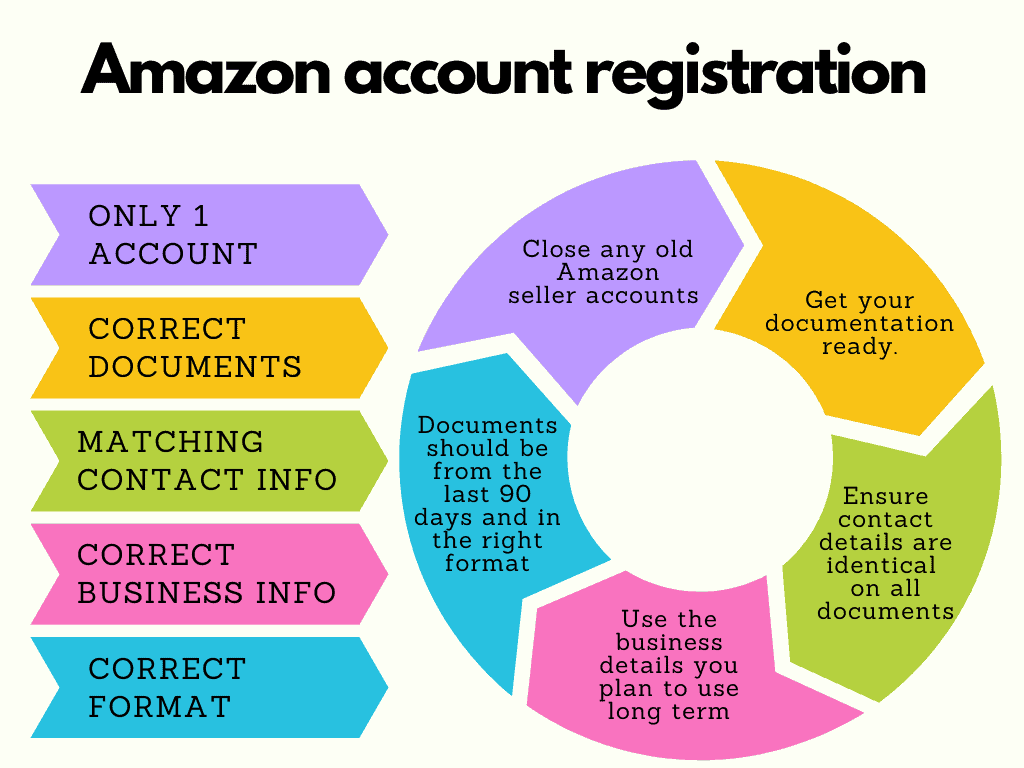
Amazon registration process
Please note that the following steps apply to the application process for Amazon US (the US covers Mexico and Canada too with no additional charge), however, the application process for Amazon UK is very similar.
I’ve included some screenshots to make the process clearer but as I’ve mentioned, Amazon is always updating its systems so if your screen looks slightly different, don’t be alarmed!
Before you begin, sign out of your Amazon buying account if you have one.
STEP 1
Visit the sign-up page on Amazon.
STEP 2: ACCOUNT TYPE
Choose between an individual or a Professional seller account. You should select a professional seller account.
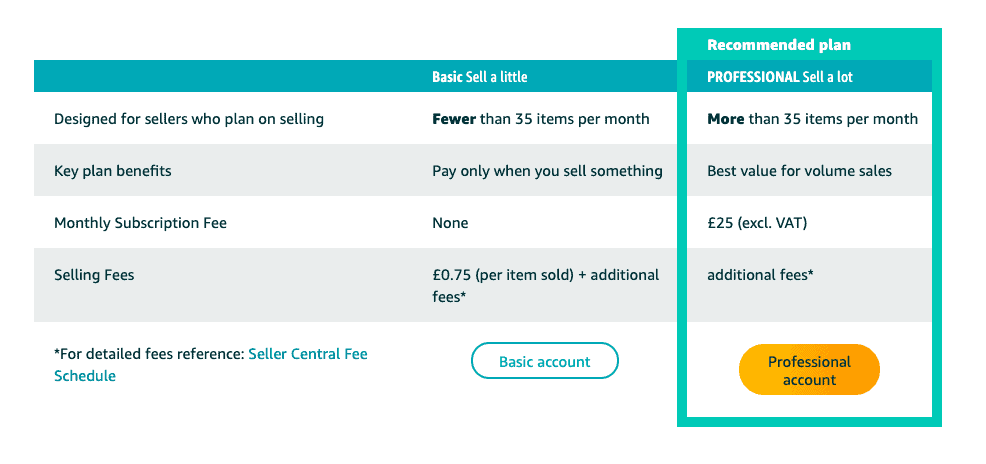
STEP 3: EMAIL ADDRESS
I would recommend using a business email address not a personal email. Amazon will then ask you to verify it.
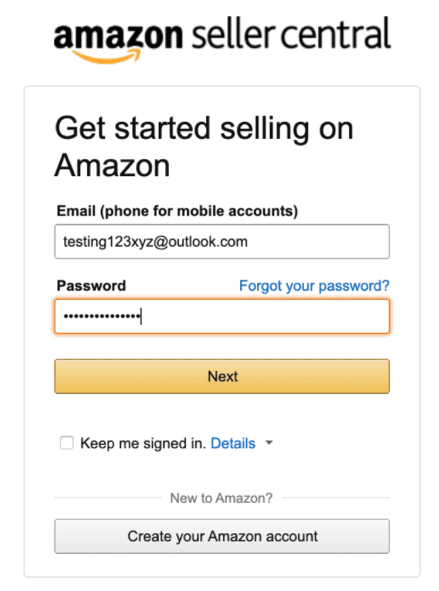
STEP 4: BUSINESS INFORMATION
- Enter the country where your business is based.
- If you have set up a business then you should select a Privately-owned business.
- Enter your name as it appears on your government ID.
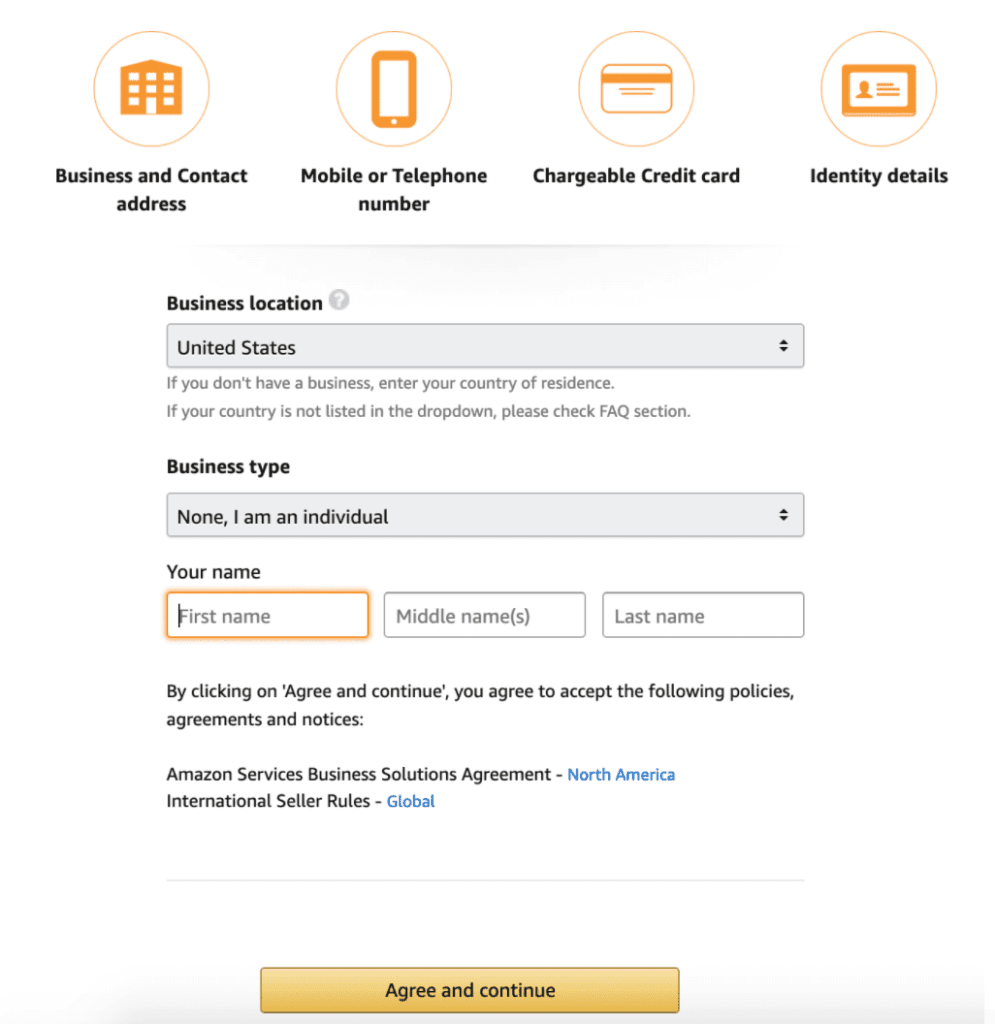
STEP 5: PERSONAL INFORMATION
Enter your personal details and address.
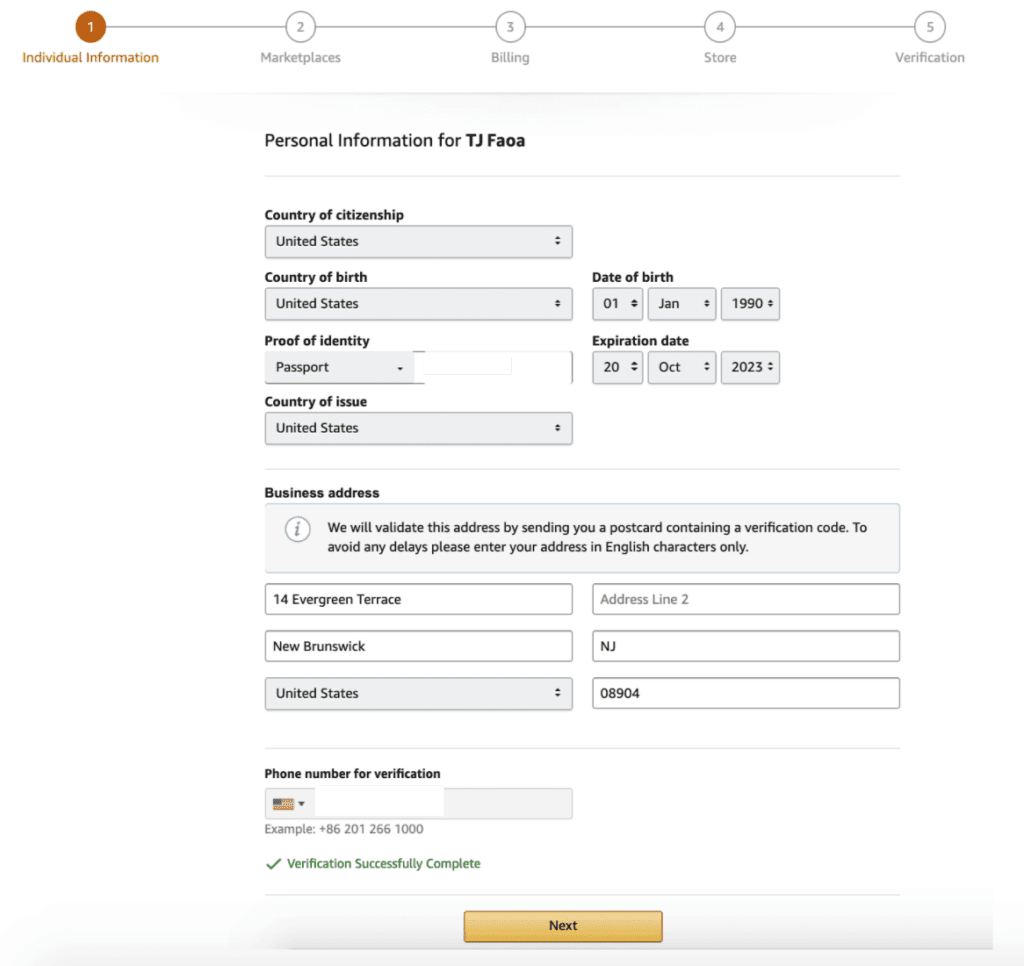
STEP 6: MARKETPLACE
Choose the marketplace you want to sell in.
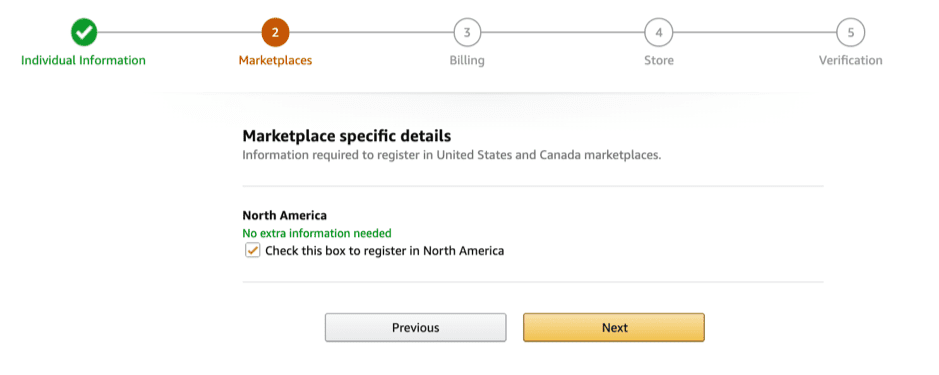
STEP 7: CREDIT CARD DETAILS
Amazon requires a credit card rather than a debit card as it wants to ensure that you still pay the monthly selling fee regardless of how much money there is in your account.
As I’ve mentioned the monthly selling fee is waived for handmade sellers so this is just a formality.
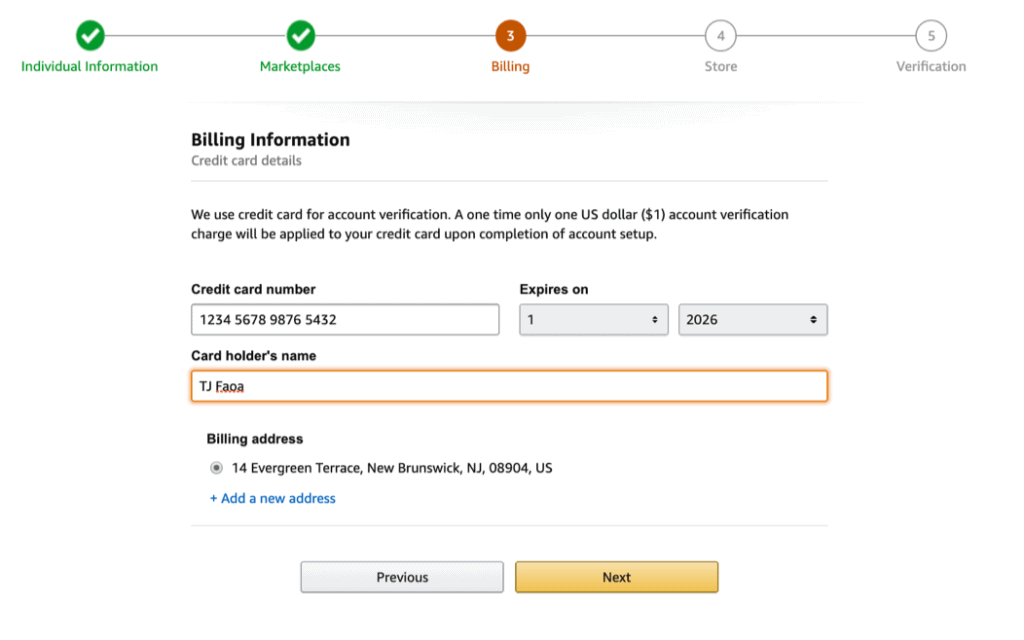
STEP 8: STORE INFORMATION
- The name of your Amazon store: This doesn’t have to be the same as your business name and it can be changed later on.
- Select yes you have UPC codes for your product(s).
- Select yes you are the manufacturer and/or brand owner of the product(s) you’re selling.
- Select yes or no depending on if you have a registered trademark for your product(s).
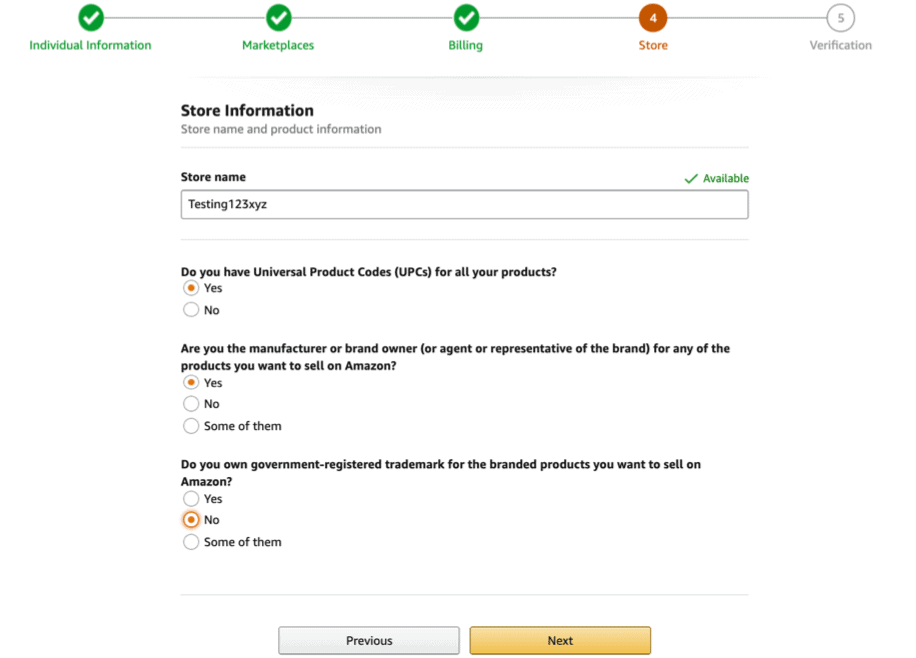
Once you’ve submitted all your details, Amazon will review them and email you to let you know whether you have been verified or if they require further information. The verification process can take a few weeks so don’t panic if you don’t hear back from Amazon right away.
Creating a Amazon Handmade seller account
Before you begin, log out of your Amazon account and make sure you have the following ready:
- A short summary (around 120 words) describing how you make your products and what materials you use.
- Images of your products, production area and process in JPEG format.
TIP: If you would like some help with creating your summary, download my Amazon Handmade application template here.
Once you have your description and photos ready, visit the Amazon Handmade page and click “Apply to Sell”, you will then be taken to the application page.
STEP 1: TELL US ABOUT YOU
Once you have your description and photos ready, visit the Amazon Handmade page and click “Apply to Sell”, you will then be taken to the application page.
- Choose the marketplace you want to sell in from the popup that appears. Amazon Handmade is currently available in the United States, Canada, Mexico, United Kingdom, Germany, France, Spain and Italy.
- Then add your name, email and the type of Maker category that you fit within.
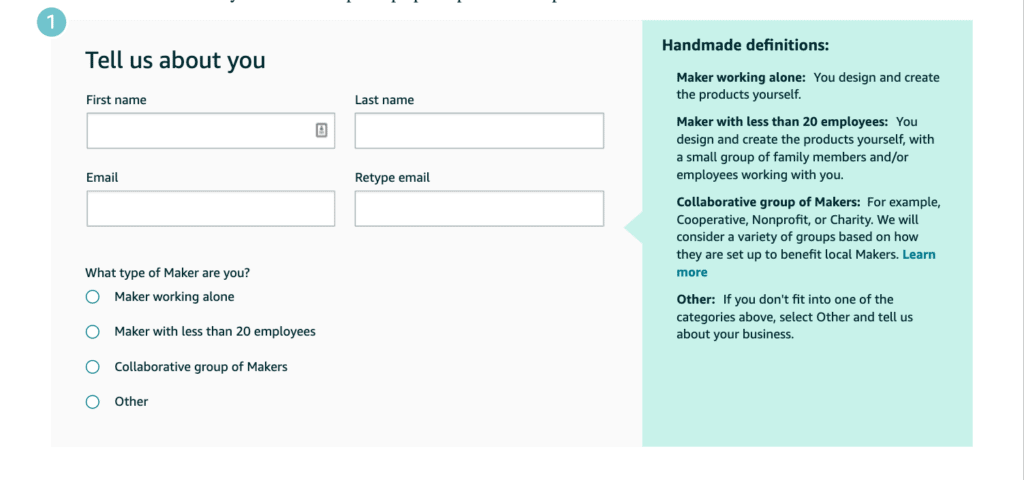
STEP 2: TELL US ABOUT YOUR WORK
Then select the type of handmade product you make and the category which best describes your production process and the amount of work carried out by you and/or your team.
Amazon likes to keep you on your toes by giving you a range of answer options, not all of which are correct. Make sure you keep Amazon’s requirements in mind when you’re filling out the form and don’t select the wrong answers!
For example, if you accidentally select “I purchase handmade products from Artisans and sell them” then your application is not going to be accepted. Just take your time and make sure you read all the options carefully.
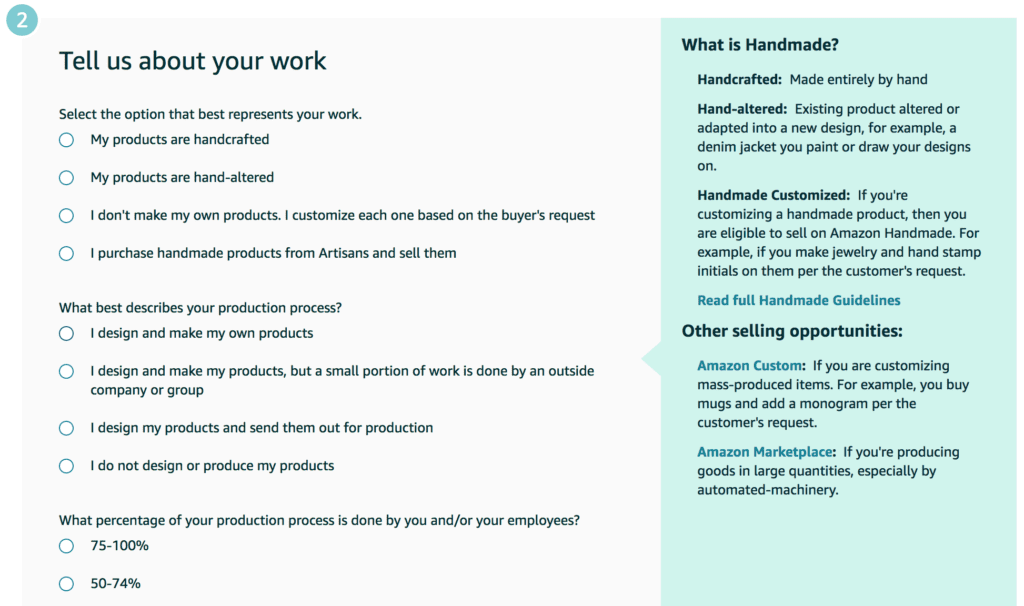
STEP 3: TELL US ABOUT YOUR PRODUCT AND PROCESSES
Next, you need to add your description which explains how you make your products and what materials you use. The more specific detail you can provide here the better.
This is your chance to explain why your products and production process are special!

STEP 4: SHOW US YOUR WORK
Now you need to upload your images. I recommend including at least 1 image of your production process as well as pictures of your finished products.
It goes without saying, choose your best pictures here!

Once you have completed all the sections you can submit your application.
Sometimes you will hear back in a couple of days and sometimes it can take longer. Don’t worry if it takes a little longer, it’s not a reflection on your or your products.
Occasionally Amazon will ask for further information in order to approve your application, generally, this will be a request for additional photos or information about your production process.
Amazon can be a bit pernickety with details so just make sure you give them exactly what they ask for in exactly the format they ask for it in.
It can be frustrating dealing with Amazon but try to stay calm and professional. You will get there in the end, it just sometimes takes a little back and forth to get things sorted out.
Once you have submitted your application you’ll receive a confirmation email from Amazon with a code which you can use to check your application status.
Tools for Amazon Handmade
Before you get started with the application process, you might also want to see if your products will be a good fit for the market. My favourite Amazon tool is Helium 10 which tells you a lot of information about the sales of other products in your category and also some really useful keyword information.
In this page I go into all the innovative tools I use in much more detail. At the moment there aren’t any Amazon Handmade specific tools, which is why I like to use Helium 10.
Time to get started
I hope that having read this guide you are now feeling a little less overwhelmed by all the Amazon jargon and more confident in your ability to assess whether Amazon Handmade is the right marketplace for you.
Once you have digested the core principles in this guide and worked through the checklists you will be a step ahead of all the other handmade sellers who are still wondering where to begin with Amazon.
Getting set up on Amazon can be time-consuming and there is a big learning curve, but it’s worth the effort.
If you want some more help with Amazon Handmade, please shoot me an email. I also have a program called the Amazon Makers program which hand holds you through the entire Amazon Handmade process.
Once your products are live, you’ll be amazed at how many potential customers are waiting to buy your products just like yours.
Selling on Amazon can be truly revolutionary for your business and your life – it gave me the chance to step away from a corporate job I hated and move to another country! Just think about what it could do for you and your business.
I help sellers all day every day so if you have extra questions that are not covered in this guide, please comment below. There are very few questions that I haven’t been asked before!

24 thoughts on “How to sell on Amazon Handmade”
Best Amazon handmade guidance so for! Thanks for detailed informations with exemples..
Thanks Ahmet! Glad you found it helpful. What are you working on at the moment?
Very very helpful, thanks so much for posting this guide. Question – I had a regular Amazon seller account many years ago, should I “reactivate” that or just set up a new one? I also have an active Merch acct, not sure if that’s connected or not? TIA if you have time to answer!
Hey Char, thanks for the question! Glad you found it helpful. Great question, I would definitely try and log into the old account to make sure if its active or not. Once you have done that you can change the primary email address. Its important you check, as Amazon are really hot on people only having one account.
For the merch account, did you use the same email address?
Hi – thanks for your response. My merch account is using a different email than my old seller acct & both of those are different from my business account. I guess I need to log in and poke around a bit. Also, is it helpful or doesn’t matter to have a standalone website? I’m in the process of creating one but right now I just use Etsy.
The best thing to do Char, would be to raise a quick case to merch support and tell them you want to open a seller account, but you want to use a different email address as its a different business. Don’t tell them you already have an account, and see what they say. If they say you can only have one, then that will be your answer.
Having a website can be really helpful! Just remember you will need to drive traffic to the ite to make sales. Whereas with Amazon ad Etsy, the traffic is brought to you. So you will need to work out how best to do that, probably through google or facebook/insta ads or your own inst account.
However, having a site can bring some real credibility to your products, so if customers look you up, they can see more about you. I have a site for my business for this reason. It doens’t make many sales, but if people want to look up my business, they can see loads of info about it.
Thanks for the great questions!
Hey Teddy – it took me all this time but I finally applied to Handmade! I should hear back within 2 days. I did have to set up a new seller account, but they approved me for that in a couple of hours once the video call verification was done. Thanks for all the good info you have posted, it gave me the nudge I needed to finally do this! Fingers crossed, here’s to a profitable 2022!!!
Teddy, I was approved right away but I cannot for the life of me figure out how to create in HANDMADE. It appears that I’m listing on regular Amazon and I can’t find my storefront! Getting so frustrated, where can I find a guide for Idiots!?!
Hey Char, congrats on getting approved! Nice work! So you need to go to Inventory > Add a product. Then you need to choose the category. If you are approved for Handmade, you should be able to select Handmade as a category. Let me know how you get on 🙂
Oh my gosh, I’m having such issues – I don’t know what’s happening. Mind you, I have been selling online at various sites for over 15 years! So I don’t think it’s me???? My storefront is not updating at all. It does not look like others Handmade sellers storefronts. I have added some pictures but it’s only showing one and much smaller than what I uploaded (I thought this would show as a “home page”, but I don’t seem to have one of those, just a seller details page which shows my personal name not my business name). So, I go ahead and try to add my first product, I get all the way to the end and after submitting get some wacky error message and needless to say my product is nowhere in my Inventory. Maybe it’s just a back weekend for this! Do you have a facebook group? I need help, lol.
Hi!
First of all, thank you for all the information. Very helpful.
I’m planning to sell in The US Amazon Handmade.
Do I need UPC for each one of my products and variations? (color and/or pattern)
I don’t have a registered business yet. Do I have to open and register a business in order to sell my products? I can’t get a business bank account without it.
I have a friend that wants to work with me on the production of the product but she leaves in a different country. Can I ship the production that she handcrafted to The US to sell on Amazon Handmade?
Does it falls on drip-shipping?
Hey! Thanks for commenting, glad you found it helpful!
You shouldnt need UPCs for Amazon Handmade, but if you are selling in normal Amazon, you will need a UPC for each variation. eg you sell tshirts in s,m,l each size needs a UPC.
You also don’t need a business in order to sell on Amazon handmade, so you can use normal bank accounts.
Yes you can work with your friend on this, not a problem! Maybe when you are doing the sign up, just use one of your workstations as the example.
Does it fall on drop-shipping?
Pingback: Is Amazon Handmade worth it? - Teddy Smith
Hello, You wrote that Amazon Handmade only works in the USA and Europe,I can sell on Amazon Handmade from country Georgia(CAUCASUS)?
I was approved for Handmade but “handmade” is NOT listed under inventory, it still appears that I have a regular Amazon storefront and the add a products page is full of requests for UPC’s, trademarks, suppliers, etc, I make all my stuff at home I don’t have suppliers or partners or any suppliers or partners, etc. Watching every tutorial it seems like I’m not on Handmade at all.
Hey Doug, thanks for commenting. Have you done the handmade application? You need to do that once you have been approved for Amazon
Next time I read a blog, Hopefully it doesn’t fail me just as much as this particular one. After all, Yes, it was my choice to read through, however I really believed you would have something helpful to say. All I hear is a bunch of whining about something that you can fix if you weren’t too busy searching for attention.
Hey Wilburn, thanks for commenting? Which bits did you not understand?
Hey Thanks for your info its great and helpful, Im a maker in Australia but selling to other country’s is expensive .Can I send my products to a amazon storage place in Australia and they do the postage much cheaper.
thank you
Regards Jacky
Hi Jacky, thanks for the comment. Yes, you can use Amazon FBA for storage. You could even send your products in bulk to another country and use their FBA.
Hey Teddy, wow thank you for this blog. Finally I found information about Amazon Handmade. There is one thing I didn’t understand, what about if I am in the US, but are my designs and artisans from my country Colombia are the ones who make the product but is 100% handmade. Do you think Amazon will aprove my shop? Or just for people that made them by hand in the US?
Thank you so much
Julian
Thanks Julian! Glad you found it helpful 🙂 I think it will get approved, you should select the option that you are a cooperative of makers, that way you will be able to pass the review. Its not necessary to say that they are made in Colombia, simply tell Amazon what the manufacturing process is.
Very nice post. I just stumbled upon your weblog and wished to say that I’ve really enjoyed surfing around your blog posts. After all I will be subscribing to your feed and I hope you write again soon!